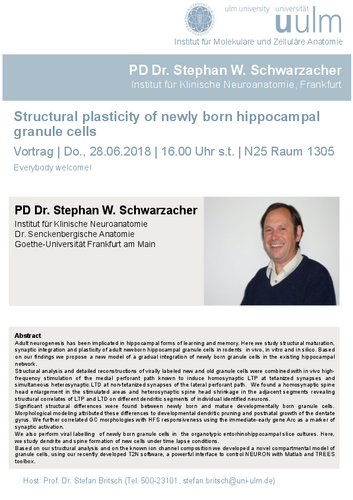Everybody welcome!
Zu Gast: PD Dr. Stephan W. Schwarzacher, Institut für Klinische Neuroanatomie, Dr. Senckenbergische Anatomie, Goethe-Universität Frankfurt am Main
Abstract des Vortrags "Structural Plasticity of newly born hippocampal granule cells"
Adult neurogenesis has been implicated in hippocampal forms of learning and memory. Here we study structural maturation, synaptic integration and plasticity of adult newborn hippocampal granule cells in rodents in vivo, in vitro and in silico. Based
on our findings we propose a new model of a gradual integration of newly born granule cells in the existing hippocampal
network.
Structural analysis and detailed reconstructions of virally labeled new and old granule cells were combined with in vivo highfrequency
stimulation of the medial perforant path known to induce homosynaptic LTP at tetanized synapses and
simultaneous heterosynaptic LTD at non-tetanized synapses of the lateral perforant path. We found a homosynaptic spine
head enlargement in the stimulated areas and heterosynaptic spine head shrinkage in the adjacent segments revealing
structural correlates of LTP and LTD on different dendritic segments of individual identified neurons.
Significant structural differences were found between newly born and mature developmentally born granule cells.
Morphological modeling attributed these differences to developmental dendritic pruning and postnatal growth of the dentate
gyrus. We further correlated GC morphologies with HFS responsiveness using the immediate-early gene Arc as a marker of
synaptic activation.
We also perform viral labelling of newly born granule cells in the organotypic entorhinohippocampal slice cultures. Here,
we study dendrite and spine formation of new cells under time lapse conditions.
Based on our structural analysis and on the known ion channel composition we developed a novel compartmental model of
granule cells, using our recently developed T2N software, a powerful interface to control NEURON with Matlab and TREES toolbox.
